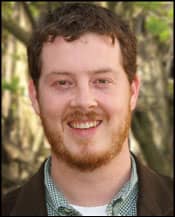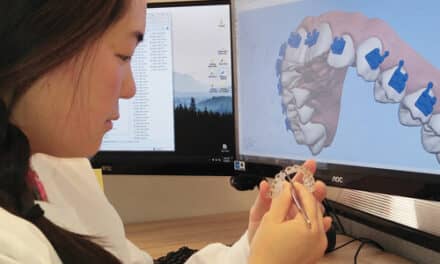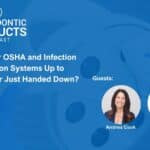
40 Years of American-Made Brackets
Wade A. Huntsman is director of marketing at American Orthodontics, Sheboygan, Wis.
OP: What is American Orthodontics’ most popular bracket?
 |
Huntsman: We have had a great deal of success with our Radiance pure sapphire bracket. The Radiance bracket is completely clear and has our patented Quad-Matte base, which provides balance in debonding. I appreciate that orthodontists hear a lot of product claims, but seeing is believing with this bracket.
OP: How does Vision LP compare to other self-ligating systems?
Huntsman: Unlike other companies that offer self-ligation, American Orthodontics does not say you have to use interactive or you have to use passive—we are not the orthodontist, we are the manufacturer. Vision LP is a fully passive system for super-low-friction mechanics. We also have T3, which is an interactive system that engages the wire late in treatment for optimal control. The Vision LP self-ligating bracket features an open/close mechanism. With the entire opening mechanism on the labial surface of the bracket, the patient is able to brush away debris that may cause the door to bind late in treatment.
OP: How does the pronounced developmental groove on the LP tubes increase bonding accuracy?
Huntsman: The developmental groove on all low profile (LP) direct bond tubes fits between the mesial and buccal cusp of the first molar, allowing accurate placement. Equally important, the pad radius mimics the contour of the clinical crown for a glovelike fit each time.
OP: Do you offer training?
Huntsman: This year, we have seminars on Vision LP Passive SL, T3 Interactive SL, Aarhus Mini-Screws, Bowman/Butterfly Product Series, and Wired for Success (which teaches residents how to move from university to practice).
OP: What else should orthodontists know about American?
Huntsman: Since 1968, American Orthodontics has focused on three things: quality, service, and value. More than 95% of our products are manufactured in Wisconsin. Because our products are American-made with our engineers on-site, we are able to maintain quality. Being local also makes it possible for us to turn custom orders around in 48 hours or less. Maintaining local control also allows us to keep costs down.
Chair Styles
Bruce Livingston is the president of Boyd Industries Inc, Clearwater, Fla.
OP: What is your most popular treatment chair?
 |
Livingston: Our most popular treatment chair is the Model M-2000FB. It features a cast aluminum frame with an all-steel subframe, operator-programmable positions that save time and increase productivity, 24-volt electrical components that eliminate shock, unlimited color selection, snap-in/snap-out upholstery, a 1-year warranty on parts and labor, and a 3-year warranty on parts.
OP: How do computer-ready chairside units speed up treatment?
Livingston: Computer units provide the orthodontist and staff a “one-stop” work center that has all the critical aspects of treating a patient—from the patient’s name, treatment plan/progress, radiographs, payment history, to his or her school. In addition, all the essential instrumentation and supplies are at chairside.
OP: How popular are E2 Gaming Systems?
Livingston: The E2 Gaming Systems are extremely popular among orthodontic patients, keeping them entertained while in the waiting room. E2 also relieves stress on the front office staff—patients no longer complain about how much longer they have to wait until their appointment.
OP: What makes your orthodontic equipment different from general dental equipment?
Livingston: Boyd orthodontic equipment is built with cast aluminum frames with steel subframes, motors load-tested to 500 pounds and 25,000 cycles, and more than 50 years of industry experience serving the orthodontic community.
- For more information about these companies, see our online Buyer’s Guide.
Orthodontic chairs also provide fixed (static) height options to keep costs down and patient positioning quick and efficient.
Time and motion studies of orthodontic practices indicate approximately 80% of the chairtime involves a single operator. Therefore, the delivery system must accommodate this technique.
All the dental instrumentation is on one side of the chair, normally delivered from the side. This provides maximum efficiency and accessibility to all of the dental instrumentation and supplies located at the chair.










